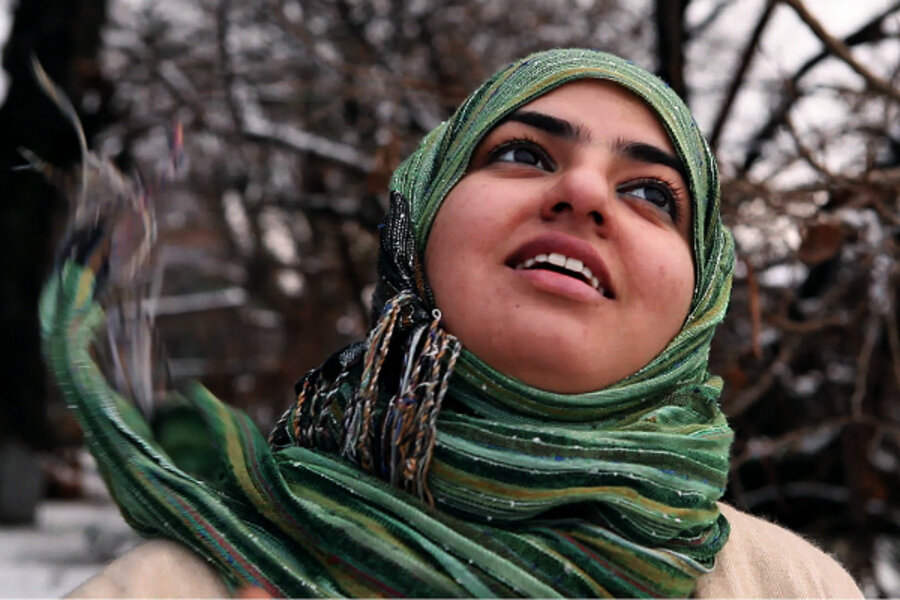Inshah Malik is trying to rebuild Kashmir with a different weapon – her pen
Loading...
| Srinagar, India-controlled Kashmir
Inshah Malik may have a plan to share with the conflict-weary women of the Arab Spring. For most of her 27 years, she has lived through a brutal clash that ripped apart her homeland in Kashmir, on the border between India and Pakistan.
Now Ms. Malik, like a growing number of other young Kashmiris, is trying to rebuild her community with a different weapon – her pen.
For communities to heal and women to gain a greater role, she says, it’s crucial that her people never forget the collective memories of women searching for their loved ones and being brutalized by conflict. Though she’s just starting out, her work might offer examples for the women of Syria, Egypt, Libya, Tunisia, and Yemen. How can they start rebuilding their communities and making a space for themselves when the protests die down and the world stops paying attention?
Malik has written a collection of stories of women from villages in a recently published book, based on her graduate thesis “Muslim Women Under the Impact of Ongoing Conflict in Kashmir.” She writes of women such as Dilfroz, who was raped in front of her family during an army search, thus bringing attention to stories that usually go unheard. She hopes to have the book reprinted in Kashmir at a reduced cost so that it can be used in the course curriculum in universities.
“In Kashmir, for the entire conflict, women have always been out there fighting,” Malik says, looking out the window of her home in Srinagar, the summer capital.
In 2010 she frantically posted Facebook updates as Indian security forces smashed these windows during massive protests. “The conflict has actually proven to be more brutal for women because ... [that] violence [was] intended to demean the community, to demean the enemy, to demean the people who are fighting the authorities,” she says.
Kashmir is one of the most militarized place in the world, with some 600,000 Indian soldiers policing the region near the Himalayas where India, Pakistan, and China converge. The military presence picked up in 1989 when Pakistani-trained militants began crossing the border into Indian-controlled Kashmir, leading to an armed movement for independence from India.
In the years that followed, Amnesty International reports, more than 70,000 people were killed, thousands of women were widowed, and thousands more were raped. By the late 1990s, the armed movement was quashed by Indian forces.
The conflict goes back to 1947, when most of Muslim-majority Kashmir was grabbed by India during the partition of India and Pakistan. Kashmiris were promised a plebiscite on their political future by the United Nations, but that vote was never allowed to happen.
In the last two decades, the movement has shifted from an armed struggle to stone-throwing protests. Now, young Kashmiris, like Malik, are turning to social media and other nonviolent tools.
Growing up in the midst of the strife in the 1990s, Malik remembers her father, uncles, brother, and other men in the neighborhood being dragged out of their houses at gunpoint during crackdowns by Indian soldiers. She recalls that the women left in their homes were terrified of being raped or molested.
Having lived through these horrifying moments, she wanted to reach out to the women in her community. She spent weeks listening to the stories of dozens of women who were raped in a single night in 1991 in Kunan Poshpora, a remote village in Kashmir.
Caught in the middle, women were raped by both soldiers and militants. But the abuse did not stop with the original attack. They were then often blamed by their families and shunned by society for what had happened to them.
Even in those bleak times, Malik writes, it was women like Raja, who was brutalized in Kunan Poshpora but spoke out against the army while helping the women raped in her village, who held society together.
“I want to give Kashmiri women a tongue to tell what they have faced,” says Malik, who is pursuing a Ph.D. on women and the Kashmiri conflict at Jawaharlal Nehru University in New Delhi.
Though protests are still important, she says it’s time that Kashmiris find other ways to advance their cause.
The women of Syria, Libya, and Egypt, who are now facing similar challenges, should pen narratives too, Malik suggests. She hopes to draw attention to crimes of sexual violence and to lobby for greater acceptance of rape victims within their communities.
While her stories are only a beginning, she’s already pushing for increased understanding of subjects long thought taboo.
Kashmiri activist Anjum Zamarud Habib, the only Kashmiri woman to be jailed under a draconian terrorist law know as the 2003 Prevention of Terrorism Act, spent five disconsolate years behind bars on terrorism charges that were later overturned. She wrote about the injustices she faced in her book “Prisoner No. 100.”
Malik has given a voice to young women – and men – who grew up during the conflict, Ms. Habib says.
“The children of conflict are more educated and more experienced” than her previous generation, she says. “My wish is that more women come forward. The movement has already been transferred to the next generation, whether they like it or not.”
But rebuilding a society fractured by war, especially for women, will not be easy. Malik, along with the young women of the Arab Spring, are now reaching for a role in society beyond what has ever existed for them before.
• Sign up to receive a weekly selection of practical and inspiring Change Agent articles by clicking here.







